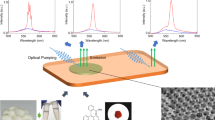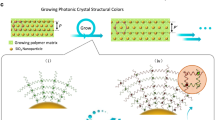Abstract
Periodic nanostructures provide the facility to control and manipulate the flow of light through their lattices. Three-dimensional photonic crystals enable the controlled design of structural colour, which can be varied by infiltrating the structure with different (typically liquid) fillers. Here, we report three-dimensional photonic crystals composed entirely of a purified natural protein (silk fibroin). The biocompatibility of this protein, as well as its favourable material properties and ease of biological functionalization, present opportunities for otherwise unattainable device applications such as bioresorbable integration of structural colour within living tissue or lattice functionalization by means of organic and inorganic material doping. We present a silk inverse opal that demonstrates a pseudo-photonic bandgap in the visible spectrum and show its associated structural colour beneath biological tissue. We also leverage silk's facile dopability to manufacture a gold nanoparticle silk inverse opal and demonstrate patterned heating mediated by enhancement of nanoparticle absorption at the band-edge frequency of the photonic crystal.
This is a preview of subscription content, access via your institution
Access options
Subscribe to this journal
Receive 12 print issues and online access
$209.00 per year
only $17.42 per issue
Buy this article
- Purchase on Springer Link
- Instant access to full article PDF
Prices may be subject to local taxes which are calculated during checkout




Similar content being viewed by others
References
Rather, B., Hoffman, A., Schoen, F. & Lemon, J. in Biomaterials Science: An Introduction to Materials in Medicine page 10 (Academic Press, 2004).
Scheibel, T. Spider silks: recombinant synthesis, assembly, spinning, and engineering of synthetic proteins. Microb. Cell Fact. 3, 14–23 (2004).
Omenetto, F. G. & Kaplan, D. L. New opportunities for an ancient material. Science 329, 528–531 (2010).
Leal-Egana, A. & Scheibel, T. Silk-based materials for biomedical applications. Biotechnol. Appl. Biochem. 55, 155–167 (2010).
Omenetto, F. G. & Kaplan, D. L. A new route for silk. Nature Photon. 2, 641–643 (2008).
Lawrence, B. D., Cronin-Golomb, M., Georgakoudi, I., Kaplan, D. L. & Omenetto, F. G. Bioactive silk protein biomaterial systems for optical devices. Biomacromolecules 9, 1214–1220 (2008).
Parker, S. T. et al. Biocompatible silk printed optical waveguides. Adv. Mater. 21, 2411–2415 (2009).
Perry, H., Gopinath, A., Kaplan, D. L., Negro, L. D. & Omenetto F. G. Nano- and micropatterning of optically transparent, mechanically robust, biocompatible silk fibroin films. Adv. Mater. 20, 3070–3072 (2008).
Demura, M., Asakura, T., Nakamura, E. & Tamura, H. Immobilization of peroxidase with a Bombyx mori silk fibroin membrane and its application to biophotosensors. J. Biotech. 10, 113–119 (1989).
Domachuk, P., Perry, H., Amsden, J. J., Kaplan, D. L. & Omenetto, F. G. Bioactive ‘self-sensing’ optical systems. Appl. Phys. Lett. 95, 253702 (2009).
Prasad, P. N. in Introduction to Biophotonics Ch. 15 (Wiley, 2003).
Alivisatos, P. The use of nanocrystals in biological detection. Nature Biotechnol. 22, 47–52 (2004).
Kim, S-H., Lee, S. Y., Yang, S-M. & Yi, G-R. Self-assembled colloidal structures for photonics. NPG Asia Mater. 3, 25–33 (2011).
Asher, S. A., Peteu, S. F., Reese, C. E., Lin, M. X. & Finegold, D. Polymerized crystalline colloidal array chemical-sensing materials for detection of lead in body fluids. Anal. Bioanal. Chem. 373, 632–638 (2002).
Bonifacio, L. D. et al. Towards the photonic nose: a novel platform for molecule and bacteria identification. Adv. Mater. 22, 1351–1354 (2010).
Yablonovitch, E. Inhibited spontaneous emission in solid-state physics and electronics. Phys. Rev. Lett. 58, 2059–2062 (1987).
Fujishima, M., Sakata, S., Iwasaki, T. & Uchida, K. Implantable photonic crystal for reflection-based optical sensing of biodegradation. J. Mater. Sci. 43, 1890–1896 (2008).
Hunt, H. K. & Armani, A. M. Label-free biological and chemical sensing. Nanoscale 2, 1544–1559 (2010).
Swinerd, V. M., Collins, A. M., Skaer, N. J. V., Gheysens, T. & Mann, S. Silk inverse opals from template-directed beta sheet transformation of regenerated silk fibroin. Soft Matter 3, 1377–1380 (2007).
Xia, Y., Gates, B., Yin, Y. & Lu, Y. Monodispersed colloidal spheres: old materials with new applications. Adv. Mater. 12, 693–713 (2000).
Wijnhoven, J. E. G. J. & Vos, W. L. Preparation of photonic crystals made of air spheres in titania. Science 281, 802–804 (1998).
Tarhan, I. I. & Watson, G. H. Photonic band structure of fcc colloidal crystals. Phys. Rev. Lett. 76, 315–318 (1996).
Kim, S., Lee, J., Jeon, H. & Kim. H. J. Fiber-coupled surface-emitting photonic crystal band edge laser for biochemical sensor applications. Appl. Phys. Lett. 94, 133503 (2009).
Tan, Y., Quan, W., Ding, S. & Wang, Y. Gold-nanoparticle-infiltrated polystyrene inverse opals: a three-dimensional platform for generating combined optical properties. Chem. Mater. 18, 3385–3389 (2006).
Sanchez-Sobrado, O. et al. Interplay of resonant cavity modes with localized surface plasmons: optical absorption properties of Bragg stack integrating gold nanoparticles. Adv. Mater. 23, 2108–2112 (2011).
Lal, S., Clare, S. E. & Halas, N. J. Nanoshell-enabled photothermal cancer therapy: impending clinical impact. Acc. Chem. Res. 41, 1842–1851 (2008).
Qin, Z. & Bischof, J. C. Thermophysical and biological responses of gold nanoparticle laser heating. Chem. Soc. Rev. 41, 1191–1217 (2012).
Jain, P. K., Huang, X., El-Sayed, I. H. & El-Sayed, M. A. Noble metals on the nanoscale: optical and photothermal properties and some applications in imaging, sensing, biology, and medicine. Acc. Chem. Res. 41, 1578–1586 (2008).
Acknowledgements
This material was based on work supported in part by the US Army Research Laboratory and the US Army Research Office (contract no. W911 NF-07-1-0618) and by DARPA-DSO (H.T., S.M.S., M.A.B., D.L.K., J.J.A. and F.G.O.) and the AFOSR. SEM images were obtained at the Center for Nanoscale Systems (CNS), a member of the National Nanotechnology Infrastructure Network (NNIN), which is supported by the National Science Foundation (award no. ECS-0335765). CNS is part of the Faculty of Arts and Sciences at Harvard University.
Author information
Authors and Affiliations
Contributions
S.K. and F.G.O. conceived and performed SIO fabrication, optical measurements, computational work and data analysis. A.N.M. and J.D.S. contributed to the fabrication of water-insoluble opal and optical measurements. H.T. contributed to the laser-heating experiment. D.L.K and F.G.O. supervised the project. S.K. and F.G.O. wrote the paper. All authors commented on the results and the manuscript.
Corresponding author
Ethics declarations
Competing interests
The authors declare no competing financial interests.
Supplementary information
Supplementary information
Supplementary information (PDF 1498 kb)
Rights and permissions
About this article
Cite this article
Kim, S., Mitropoulos, A., Spitzberg, J. et al. Silk inverse opals. Nature Photon 6, 818–823 (2012). https://doi.org/10.1038/nphoton.2012.264
Received:
Accepted:
Published:
Issue Date:
DOI: https://doi.org/10.1038/nphoton.2012.264
This article is cited by
-
A microscale soft ionic power source modulates neuronal network activity
Nature (2023)
-
Scalable optical manufacture of dynamic structural colour in stretchable materials
Nature Materials (2022)
-
Chemical syntheses of bioinspired and biomimetic polymers toward biobased materials
Nature Reviews Chemistry (2021)
-
Dynamic multimodal holograms of conjugated organogels via dithering mask lithography
Nature Materials (2021)
-
Photothermal, ultra-thin, and biocompatible carbon nanotube/silk nanofiber membrane
Journal of the Korean Physical Society (2021)



